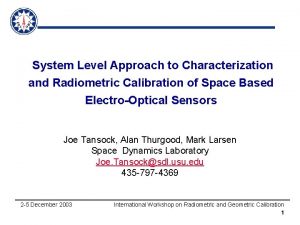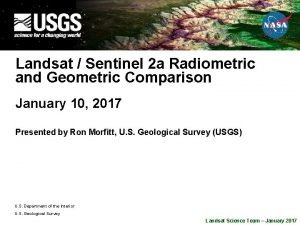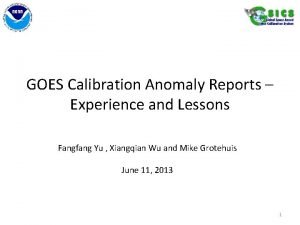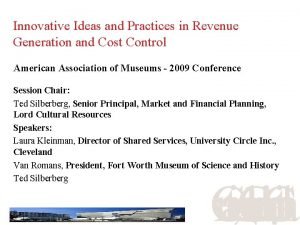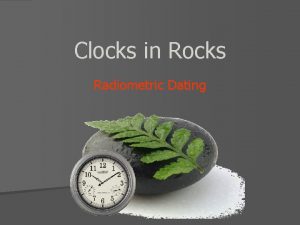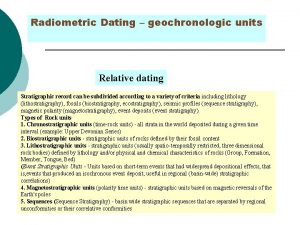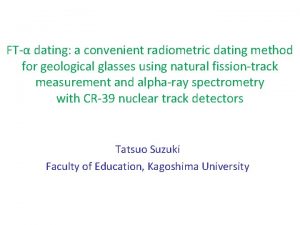Radiometric Dating Radiometric Dating You have visited museums











- Slides: 11

Radiometric Dating

Radiometric Dating You have visited museums many times, and always hear of the age of dinosaurs. Millions of years old, but how do they know? Here’s how they determine this.

Thanks to Atoms It all starts in the nucleus of an atom Atoms, as you know, are made of smaller particles: protons, neutrons, & electrons.

Radioactive Decay Some of these atoms are unstable, meaning their nuclei may fall apart (so to speak), ejecting some of these particles to become new atoms.

Radioisotopes You may never know which atom will decay and when, but there seems to be a fairly steady rate of decay. It is this steady rate that allows scientists to determine the age of a fossil.

Cosmic Radiation & Carbon -14 One of the most common forms of dating is Carbon-14 makes up 1 trillionth of the percentage of carbon on earth, and is created by cosmic radiation It is then absorbed by living plants and animals

How Carbon-14 Is Produced Cosmic Rays (radiation) Forms C-14 Collision with atmosphere (N-14) C-14 combines with oxygen to form carbon dioxide (CO 2)

Carbon Dating When plants or animals die, they stop absorbing this material. The unstable carbon-14 then decays into the stable nitrogen-14 atom. The amount of this decay is then compared to the amount of carbon-14 in living beings today.

How to determine age All the scientist must do then is calculate this simple formula… t = [ ln (Nf/No) / (-0. 693) ] x t 1/2 …where ln is the natural logarithm, Nf/No is the amount of carbon-14 in the sample compared to the amount in living tissue, and t 1/2 is the half-life

Simple enough? Although, the formula may not be simple, hopefully the concept is. OR NOT?

Sources Illustrations taken from www. icr. org
 Formula for carbon dating
Formula for carbon dating How many states have you been to
How many states have you been to You have been visited by the legg
You have been visited by the legg Dating patterns since the 1960s are
Dating patterns since the 1960s are I have visited again poem
I have visited again poem Http://solarsystem.nasa.gov/planets/
Http://solarsystem.nasa.gov/planets/ Temporal resolution example
Temporal resolution example Radiometric calibration
Radiometric calibration Radiometric error
Radiometric error üspace
üspace Archives and museums du study material
Archives and museums du study material Innovative ideas for revenue generation
Innovative ideas for revenue generation







